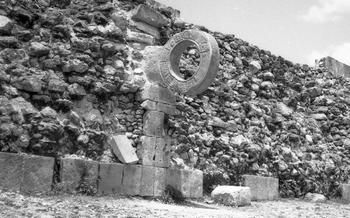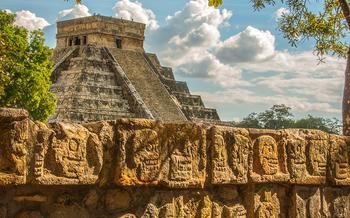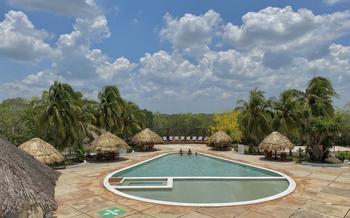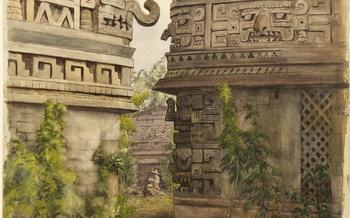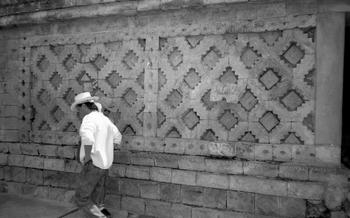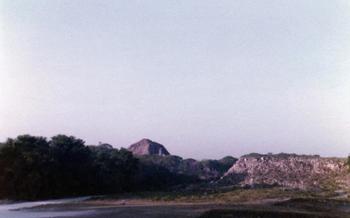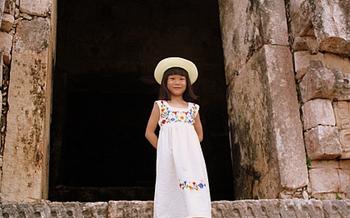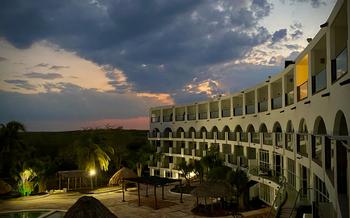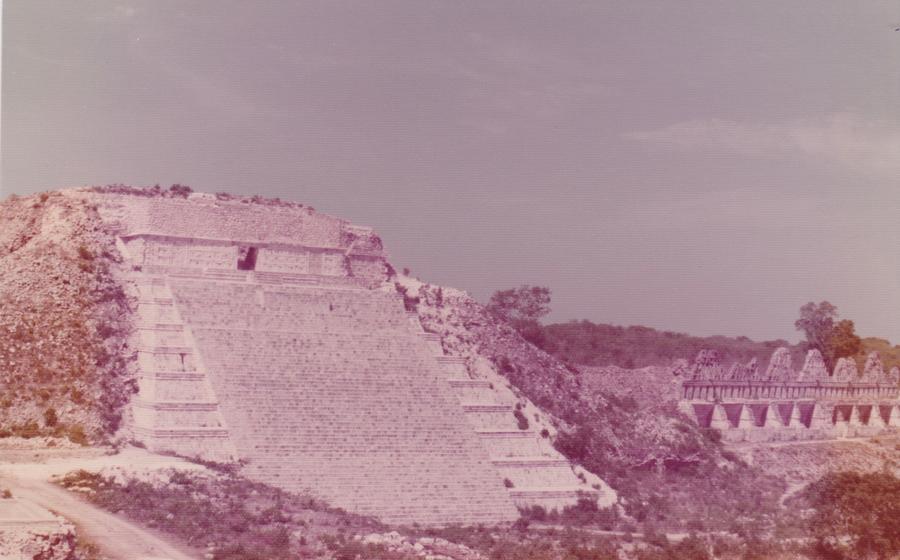
Great Pyramid of Uxmal
- Uxmal, a Majestic City in the Yucatan Peninsula:
- The Great Pyramid of Uxmal, a Masterpiece of Mayan Architecture
- Exploring the Ruins of Uxmal
- Tips for Visiting Uxmal
- Guided Tours and Local Guides
- Transportation to Uxmal
- Accommodation Near Uxmal
- Dining Options Near Uxmal
- Other Activities in the Region
- Timeline of Uxmal's history and its rise to prominence as a Mayan city-state
- Uxmal's Astronomical Significance
- Insider Tip: Unveiling Uxmal's Hidden Treasures
Uxmal, a Majestic City in the Yucatan Peninsula:
Uxmal, a remarkable ancient city located in the heart of the Yucatan Peninsula, stands as a testament to the ingenuity and cultural achievements of the Maya civilization. Once a thriving city-state, Uxmal played a significant role in shaping the political, economic, and cultural landscape of the Maya world. Its well-preserved ruins, adorned with intricate carvings and towering pyramids, offer a glimpse into the grandeur and sophistication of this ancient metropolis.
Uxmal's strategic location, nestled amidst fertile lands and trade routes, contributed to its rise as a prominent center of commerce and cultural exchange. The city's proximity to other significant Mayan sites, such as Chichen Itza and Mayapan, facilitated interactions and alliances, fostering a vibrant cultural and intellectual environment.
The architectural style of Uxmal is a unique blend of Puuc and Maya traditions, characterized by its low, elongated buildings, intricate stone carvings, and corbelled arches. This distinctive style sets Uxmal apart from other Mayan cities and showcases the exceptional craftsmanship and artistic prowess of its builders.
Uxmal's cultural importance has been recognized by UNESCO, which designated it as a World Heritage Site in 199This prestigious recognition underscores the site's exceptional value and its significance in preserving and celebrating the rich cultural heritage of the Maya civilization.
The Great Pyramid of Uxmal, a Masterpiece of Mayan Architecture
The Great Pyramid of Uxmal, also known as the Pyramid of the Magician, stands as a testament to the ingenuity and architectural prowess of the ancient Maya. Its construction, shrouded in mystery and legend, is believed to have taken place around the 10th century AD, during the height of Uxmal's power and influence.
The pyramid's history is intertwined with the mythical figure of the magician, or priest, who is said to have built it in a single night with the help of supernatural forces. According to legend, the magician was challenged by a rival to build a taller pyramid than his own, and the Great Pyramid was the result of this legendary contest.
Constructed using limestone blocks, the pyramid rises to an impressive height of 115 feet (35 meters), with a square base measuring 150 feet (46 meters) on each side. Its remarkable precision and symmetry showcase the advanced engineering skills of the Maya, who used sophisticated techniques to align the pyramid with celestial events, such as the summer solstice.
The pyramid's design features a series of five terraces, each adorned with intricate carvings and sculptures depicting Mayan deities, rulers, and mythical creatures. These carvings provide valuable insights into the religious beliefs and cultural practices of the ancient Maya, offering a glimpse into their complex cosmology and mythology.
The Great Pyramid of Uxmal is not only an architectural masterpiece but also a symbol of the city's power and prestige. It served as a temple, a place of worship, and a royal palace, housing the ruling elite and their families. Its impressive size and elaborate decoration reflect the wealth and influence of Uxmal, a city that once stood as a beacon of Mayan civilization in the Yucatan Peninsula.
Exploring the Ruins of Uxmal
Uxmal's archaeological site encompasses a vast area filled with impressive structures, each with its own unique character and significance. The layout of the site is organized into several sections, including the Great Pyramid, the Governor's Palace, the Nunnery Quadrangle, and the Juego de Pelota (ball court).
The Governor's Palace is one of the most iconic buildings in Uxmal. This grand palace features intricate carvings and sculptures depicting Mayan rulers, deities, and mythical creatures. The Nunnery Quadrangle is another notable structure, consisting of a series of interconnected buildings that were likely used for religious purposes. The Juego de Pelota is a large playing field where the ancient Maya engaged in the ritual ball game, which held deep cultural and religious significance.
As you explore Uxmal's ruins, be sure to take note of the numerous carvings, sculptures, and hieroglyphs that adorn the buildings and monuments. These artistic expressions provide valuable insights into Mayan mythology, history, and daily life. The site is also home to several cenotes, which were natural wells that provided water for the ancient Maya and are considered sacred by the Maya people.
Uxmal's ruins are currently under ongoing restoration efforts, aimed at preserving and protecting this invaluable cultural heritage for future generations. Visitors can witness the progress of these restoration projects and gain a deeper understanding of the archaeological processes involved in preserving ancient sites.
Tips for Visiting Uxmal
To ensure a memorable and fulfilling experience at Uxmal, careful planning and preparation are essential. The best time to visit is during the dry season, which runs from November to April, to avoid the intense heat and humidity of the summer months. Aim to arrive early in the morning to beat the crowds and enjoy the cooler temperatures. Dedicate at least half a day to fully explore the site and appreciate its grandeur.
When packing for your visit, prioritize comfort and practicality. Wear lightweight, breathable clothing that allows for freedom of movement. Sturdy, closed-toe shoes are recommended for navigating the uneven terrain of the ruins. Don't forget to bring a hat, sunglasses, and sunscreen to protect yourself from the sun.
To fully immerse yourself in Uxmal's rich history and culture, consider hiring a certified guide. These knowledgeable professionals can provide insights into the site's significance, symbolism, and ancient Mayan life. Guided tours are available in various languages and can be tailored to your interests and preferences.
Lastly, remember to bring essential items such as water, snacks, and insect repellent. While there are limited food and beverage options available on-site, it's advisable to come prepared, especially during the hot summer months.
Guided Tours and Local Guides
Exploring Uxmal with a certified guide is highly recommended. These knowledgeable experts provide in-depth insights into the site's history, culture, and architecture. They can point out hidden details, explain the significance of carvings and hieroglyphs, and answer your questions.
Various tour options are available, including group tours, private tours, and customized itineraries. Group tours offer a budget-friendly option and the chance to meet fellow travelers. Private tours provide a more personalized experience, allowing you to set your own pace and explore at your leisure.
To choose a reputable tour operator, look for companies that are licensed, experienced, and have positive reviews. Ensure that your guide is certified by the Mexican Association of Tourist Guides (AMGT). This certification guarantees their knowledge, professionalism, and adherence to ethical standards.
When interacting with local guides, be respectful and mindful of their culture. Ask questions, show genuine interest, and avoid interrupting their explanations. Remember, these guides are passionate about sharing their heritage and want to ensure you have a meaningful and enriching experience.
Transportation to Uxmal
Getting to Uxmal is relatively straightforward, with several transportation options available from major cities in the Yucatan Peninsula. The distance from popular tourist destinations like Cancun, Merida, and Chichen Itza varies, but all offer convenient routes to Uxmal.
Public transportation is a budget-friendly option, with regular buses departing from Merida's central bus station. While buses are generally reliable, they can be crowded and uncomfortable, especially during peak tourist season.
Renting a car provides greater flexibility and allows for spontaneous exploration of the region. Rental cars are available at Cancun International Airport and other major cities in the Yucatan. Driving in Mexico is generally safe, but it's essential to be aware of local customs and road conditions.
Organized tours are a convenient option for those who prefer a hassle-free experience. Many tour operators offer day trips or multi-day itineraries that include transportation, guided tours of Uxmal, and visits to other attractions in the region.
When choosing a mode of transport, consider factors such as cost, convenience, and your desired level of independence. For a budget-friendly option, public transportation or a rental car might be suitable. If you prefer a more structured experience, an organized tour is a great choice.
Accommodation Near Uxmal
When visiting Uxmal, travelers have a range of accommodation options to choose from, catering to different budgets and preferences. Numerous hotels are situated in the vicinity of the archaeological site, offering convenience and proximity to the ancient ruins. These hotels vary from budget-friendly options to luxurious resorts, providing a diverse selection for visitors.
For those seeking a comfortable and affordable stay, several budget-friendly hotels are located within a short distance from Uxmal. These hotels offer basic amenities and a clean, comfortable environment, allowing travelers to focus on exploring the ruins without breaking the bank.
If you prefer a more upscale experience, several luxury hotels are nestled near the archaeological site, offering a range of amenities and services to enhance your stay. These hotels often feature swimming pools, restaurants, and tour desks, providing a convenient and relaxing base for your Uxmal adventure.
When selecting a hotel near Uxmal, consider factors such as proximity to the archaeological site, amenities offered, and your budget. Advance booking is recommended, especially during peak tourist season, to secure your preferred accommodation and avoid disappointment.
Dining Options Near Uxmal
Uxmal's proximity to the city of Mérida offers a diverse culinary scene with a blend of traditional Yucatecan cuisine and international flavors. Within the vicinity of the archaeological site, you can find several restaurants and cafes catering to tourists and locals alike.
For an authentic taste of Mayan cuisine, try dishes like cochinita pibil, a slow-roasted pork dish marinated in achiote and wrapped in banana leaves. Panuchos and salbutes, fried tortillas topped with beans, shredded meat, and pickled onions, are also popular local delicacies.
To support local businesses and experience the true flavors of the region, venture out to nearby villages and markets. Here, you can find fresh produce, homemade tortillas, and traditional Mayan dishes prepared with love and care.
If you prefer to pack a lunch for your visit to the archaeological site, there are several options available. Bring along sandwiches, fruits, and snacks to keep your energy levels up while exploring the ruins.
Insider Tip: Be sure to try the local fruit juices, especially the refreshing agua de lima, made with fresh limes and sugar. It's the perfect way to cool down on a hot day and stay hydrated while exploring Uxmal.
Other Activities in the Region
Uxmal's allure extends beyond its ancient ruins. The surrounding region offers a diverse range of attractions that complement a visit to this Mayan city-state. Immerse yourself in the natural wonders of the Yucatan Peninsula, where cenotes, caves, and verdant reserves await exploration. Discover hidden gems like the Grutas de Loltún, an extensive cave system adorned with stalactites and stalagmites. Swim in the crystal-clear waters of cenotes such as Cenote Azul or Cenote Xlacah, surrounded by lush vegetation.
Venture beyond Uxmal to explore other captivating Mayan ruins in the region. Chichén Itzá, with its iconic pyramid El Castillo, is a must-see for any history enthusiast. Ek Balam, with its well-preserved structures and intricate carvings, offers a glimpse into the lives of the ancient Maya. Each site boasts unique features and provides an opportunity to delve deeper into the rich Mayan heritage.
Immerse yourself in the vibrant culture of the region by visiting local villages and attending traditional markets. Engage with the friendly locals, learn about their customs, and support their economy by purchasing handmade crafts and souvenirs. Partake in cooking classes to learn the secrets of authentic Mayan cuisine, savoring the flavors of cochinita pibil, panuchos, and salbutes. Discover the ancient traditions of the Maya through live performances, storytelling sessions, and workshops that showcase their cultural heritage.
Timeline of Uxmal's history and its rise to prominence as a Mayan city-state
- Uxmal's origins date back to the Classic period of Mayan civilization, around the 6th century AD.
- The city reached its peak during the Late Classic period (800-1000 AD), becoming one of the most powerful and influential Mayan city-states in the region.
- Uxmal's rise to prominence was marked by its strategic location on trade routes, its agricultural prowess, and its advanced water management systems.
- The city's rulers played a crucial role in maintaining political alliances and expanding Uxmal's influence throughout the Puuc region.
- By the 10th century AD, Uxmal had become a major cultural and economic center and continued to thrive until the arrival of the Spanish in the 16th century.
Uxmal's Astronomical Significance
The Maya were renowned for their advanced understanding of astronomy, and Uxmal is a testament to their celestial knowledge. The city's architecture and urban planning were carefully aligned with astronomical events, demonstrating the deep connection between the Maya and the cosmos.
Buildings and structures in Uxmal are positioned to align with the movements of the sun, moon, and stars. The Great Pyramid, for instance, is oriented towards the summer solstice sunset, creating a breathtaking celestial spectacle during the longest day of the year. Other structures, such as the Nunnery Quadrangle, are aligned with the winter solstice sunrise, marking the beginning of a new agricultural cycle.
The Maya used these alignments to create calendars, predict astronomical phenomena, and guide their agricultural practices. The precise positioning of buildings and monuments at Uxmal suggests a sophisticated understanding of astronomy and a deep reverence for the natural world.
Exploring Uxmal's astronomical connections offers a glimpse into the complex and fascinating world of Maya culture. It highlights the Maya's ability to observe and understand the cosmos, using their knowledge to shape their city's architecture and guide their daily lives.
Insider Tip: Unveiling Uxmal's Hidden Treasures
Beyond the well-trodden paths of Uxmal's main attractions, there lie hidden gems waiting to be discovered by curious explorers. Venture off the beaten track to uncover lesser-known areas of the archaeological site that offer a glimpse into the city's rich history and cultural significance. Explore the intricate carvings and sculptures adorning the lesser-visited structures, each telling a unique story about Uxmal's past.
For photography enthusiasts, Uxmal presents a myriad of opportunities to capture stunning images. As the golden rays of the sun cast long shadows across the ancient ruins, seize the chance to immortalize the majesty of Uxmal in your lens. Experiment with different angles and perspectives to create captivating compositions that showcase the architectural wonders of this ancient city.
Immerse yourself in the vibrant culture of the Maya by visiting local markets and shops near Uxmal. Here, you can purchase authentic Mayan souvenirs and handicrafts, supporting the local economy while taking home a piece of Uxmal's heritage. From colorful textiles and intricate pottery to hand-carved wooden figurines, these unique items offer a tangible connection to the living traditions of the Maya people.
For a truly unforgettable experience, consider attending a traditional Mayan ceremony or participating in a hands-on workshop. These immersive activities provide a deeper understanding of Mayan culture and spirituality. Learn about the ancient rituals, participate in traditional dances, or try your hand at creating your own Mayan crafts, taking home not just souvenirs but cherished memories of your Uxmal adventure.
